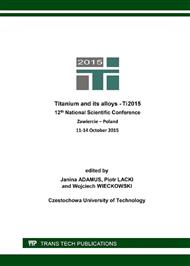p.111
p.117
p.125
p.133
p.141
p.149
p.155
p.163
p.171
Comparative Analysis of Forging Rolling and Cross-Wedge Rolling of Forgings from Titanium Alloy Ti6Al4V
Abstract:
Theoretical-experimental results of forging rolling and cross-wedge rolling of stepped shafts forgings from titanium alloy Ti6Al4V are presented in this paper. Theoretical assumptions were based on the results of numerical simulations conducted by means of finite element method with the application of software Simufact Forming. During numerical simulations optimal parameters of the rolling processes were determined in view to possibility of obtaining forgings of assumed quality and stable process course. Experimental verification was conducted in universal forging rolling mill of own design, which allows for realization of such processes as splitting without waste, forging rolling and cross as well as cross-wedge rolling processes. During conducted research influence of the way of rolling on the obtained parts quality and the process force parameters were determined. Complex analysis of the chosen rolling parameters impact on the rolling process course and quality of finished products was made. Conducted research showed that it is possible to roll axi-symmetrical forgings of stepped shafts both in transverse and longitudinal arrangement. However, forgings rolled crosswise are characterized by larger precision than in comparison with semi-finished products in longitudinal arrangement.
Info:
Periodical:
Pages:
141-148
Citation:
Online since:
April 2016
Authors:
Price:
Сopyright:
© 2016 Trans Tech Publications Ltd. All Rights Reserved
Share:
Citation:


